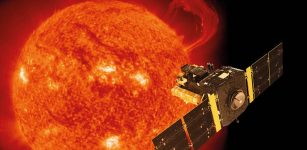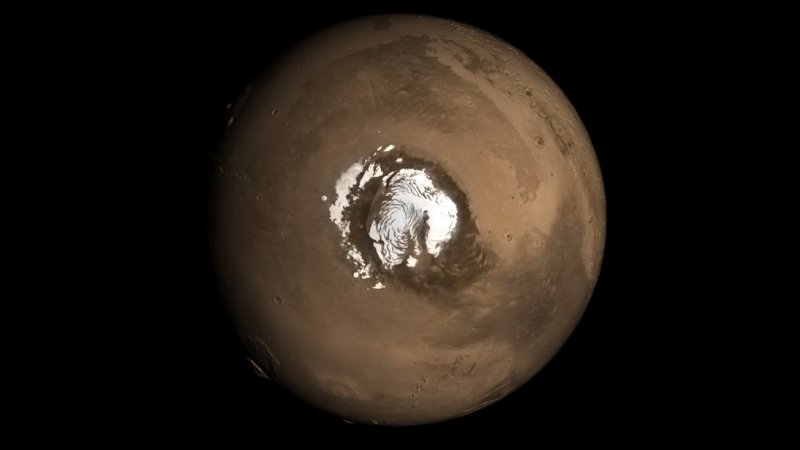Secret Behind Jupiter’s ‘Energy Crisis’ Revealed
Eddie Gonzales Jr. – MessageToEagle.com – New research published in Nature has revealed the solution to Jupiter’s ‘energy crisis’, which has puzzled astronomers for decades.
Space scientists at the University of Leicester worked with colleagues from the Japanese Space Agency (JAXA), Boston University, NASA’s Goddard Space Flight Center and the National Institute of Information and Communications Technology (NICT) to reveal the mechanism behind Jupiter’s atmospheric heating.
Jupiter is shown in visible light for context underneath an artistic impression of the Jovian upper atmosphere’s infrared glow. The brightness of this upper atmosphere layer corresponds to temperatures, from hot to cold, in this order: white, yellow, bright red and lastly, dark red. The aurorae are the hottest regions and the image shows how heat may be carried by winds away from the aurora and cause planet-wide heating. Credit: J. O'Donoghue (JAXA)/Hubble/NASA/ESA/A. Simon/J. Schmidt
Now, using data from the Keck Observatory in Hawai’i, astronomers have created the most-detailed yet global map of the gas giant’s upper atmosphere, confirming for the first time that Jupiter’s powerful aurorae are responsible for delivering planet-wide heating.
Dr. James O’Donoghue is a researcher at JAXA and completed his Ph.D. at Leicester, and is lead author for the research paper. He said:
“We first began trying to create a global heat map of Jupiter’s uppermost atmosphere at the University of Leicester. The signal was not bright enough to reveal anything outside of Jupiter’s polar regions at the time, but with the lessons learned from that work we managed to secure time on one of the largest, most competitive telescopes on Earth some years later.
“Using the Keck telescope we produced temperature maps of extraordinary detail. We found that temperatures start very high within the aurora, as expected from previous work, but now we could observe that Jupiter’s aurora, despite taking up less than 10% of the area of the planet, appear to be heating the whole thing.
“This research started in Leicester and carried on at Boston University and NASA before ending at JAXA in Japan. Collaborators from each continent working together made this study successful, combined with data from NASA’s Juno spacecraft in orbit around Jupiter and JAXA’s Hisaki spacecraft, an observatory in space.”
Dr. Tom Stallard and Dr. Henrik Melin are both part of the School of Physics and Astronomy at the University of Leicester. Dr. Stallard added:
“There has been a very long-standing puzzle in the thin atmosphere at the top of every Giant Planet within our solar system. With every Jupiter space mission, along with ground-based observations, over the past 50 years, we have consistently measured the equatorial temperatures as being much too hot.
“This ‘energy crisis’ has been a long standing issue—do the models fail to properly model how heat flows from the aurora, or is there some other unknown heat source near the equator?
“This paper describes how we have mapped this region in unprecedented detail and have shown that, at Jupiter, the equatorial heating is directly associated with auroral heating.”
Aurorae occur when charged particles are caught in a planet’s magnetic field. These spiral along the field lines towards the planet’s magnetic poles, striking atoms and molecules in the atmosphere to release light and energy.
On Earth, this leads to the characteristic light show that forms the Aurora Borealis and Australis. At Jupiter, the material spewing from its volcanic moon, Io, leads to the most powerful aurora in the Solar System and enormous heating in the polar regions of the planet.
Although the Jovian aurorae have long been a prime candidate for heating the planet’s atmosphere, observations have previously been unable to confirm or deny this until now.
Previous maps of the upper atmospheric temperature were formed using images consisting of only several pixels. This is not enough resolution to see how the temperature might be changed across the planet, providing few clues as to the origin of the extra heat.
Orthographic projections of uncertainties in temperature are all below 5%. Long black-and-white dashed lines show Jupiter’s main auroral oval, short black-and-white dashed lines correspond to the magnetic footprint of Io, and the single thick black line corresponds to the magnetic footprint of Amalthea (as described in the main text). A visible computer-generated globe of Jupiter based on Hubble Space Telescope imagery is shown underneath the H3+ temperature projection. Image credit: NASA Goddard Space Flight Center and the Space Telescope Science Institute. Note that Jupiter is tilted differently on each date to reveal different features. The longitude and latitude gridlines shown are spaced in 60° and 10° increments, respectively. Median (and maximum) uncertainty percentiles are 2.2% (5%) for 14 April 2016 and 1.6% (5%) for 25 January 2017. b, Median Jovian H3+ temperatures found for each latitude across all longitudes. Error bars are 1σ and indicate the variation of temperature over all longitudes. The Methods describes the mapping process, and Extended Data Table 1 shows the spatial bin sizes that were used in each projection. Credit: University of Leicester
Researchers created five maps of the atmospheric temperature at different spatial resolutions, with the highest resolution map showing an average temperature measurement for squares two degrees longitude ‘high’ by two degrees latitude ‘wide’.
The team scoured more than 10,000 individual data points, only mapping points with an uncertainty of less than five per cent.
Models of the atmospheres of gas giants suggest that they work like a giant refrigerator, with heat energy drawn from the equator towards the pole, and deposited in the lower atmosphere in these pole regions.
These new findings suggest that fast-changing aurorae may drive waves of energy against this poleward flow, allowing heat to reach the equator.
Observations also showed a region of localized heating in the sub-auroral region that could be interpreted as a limited wave of heat propagating equatorward, which could be interpreted as evidence of the process driving heat transfer.
Planetary research at the University of Leicester spans the breadth of Jovian system, from the planet’s magnetosphere and atmosphere, out to its diverse collection of satellites.
Written by Eddie Gonzales Jr. MessageToEagle.com Staff












